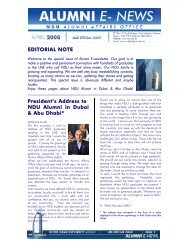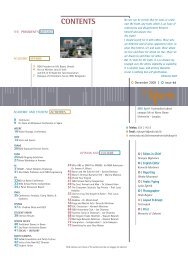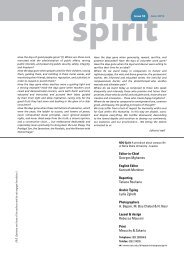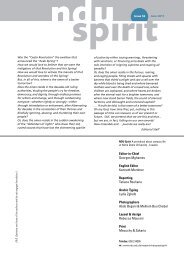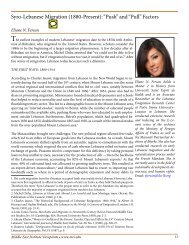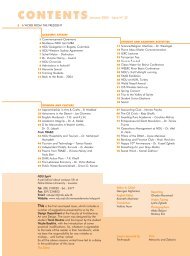OUTLINE - Notre Dame University
OUTLINE - Notre Dame University
OUTLINE - Notre Dame University
You also want an ePaper? Increase the reach of your titles
YUMPU automatically turns print PDFs into web optimized ePapers that Google loves.
Dr. Stasinopoulos was invited to<br />
cooperate with Mr. Habib Melki,<br />
Chairperson of the Design<br />
Department of FAAD and with Mr.<br />
Aram Yeretzian, Instructor at<br />
FAAD, in setting up a workshop for<br />
NDU students between the 22nd and 29th of January, 2003. The workshop<br />
focused on a coastal section of<br />
Jounieh, between the local Town<br />
Hall and the Fouad Chehab<br />
Stadium. Four teams of 3rd year students<br />
studied the current conditions<br />
in the area and presented their<br />
ideas about practical interventions<br />
that would improve the environmental<br />
aspects of outdoor spaces<br />
and the adjacent buildings.<br />
“This exercise addresses an issue<br />
that currently draws little attention”<br />
Dr. Stasinopoulos said, and he<br />
explained as follows: “The widespread<br />
lack of climatic considerations<br />
in contemporary building<br />
design is usually counterbalanced<br />
by costly mechanical means; but<br />
such artificial methods cannot be<br />
applied outdoors, where the only<br />
feasible way is to resort to natural<br />
forces. This ‘natural’ approach was<br />
honoured by traditional builders<br />
and communities for many centuries<br />
before the era of electricity<br />
and oil.”<br />
For his part, Professor Habib added:<br />
“So, in order to become familiar<br />
with the effects of climatic factors in<br />
the use of built space, the students<br />
are encouraged to explore the project<br />
area with a critical eye and<br />
point to existing positive and negative<br />
environmental and functional<br />
features, having in mind diurnal<br />
and seasonal variations. Following<br />
their observations, they are asked to<br />
suggest alterations and additions to<br />
redress the weak points that they<br />
come across.”<br />
During his staying with FAAD,<br />
Dr. Stasinopoulos gave a<br />
lecture titled “Function, Fiction,<br />
Friction –environmental crisis<br />
in architecture education.”<br />
“The lecture is a brief depiction of<br />
the current environmental status of<br />
the planet, compared with 30 years<br />
ago,” said Dr. Stasinopoulos. “Such<br />
‘time travel’ gives us a hint about the<br />
extend of changes that we should expect<br />
after 30 years. By that time our students<br />
will be using the tools we give<br />
them today, so it is very important to<br />
look at those future conditions that will<br />
shape the needs, the ideas and the priorities<br />
of the next generation.<br />
Contemporary architecture has been<br />
dealing with aesthetics and semiotics for<br />
more than 20 years, bypassing pressing<br />
problems that keep growing in absentia<br />
of architecture. It is no surprise that we<br />
hear more and more about an ‘identity<br />
crisis of architecture’ in a world increas-<br />
ingly characterised by an environmental<br />
and social crisis. So our academic<br />
duty is to seek and teach another kind of<br />
architectural attitude, one that can seriously<br />
contribute to a sustainable<br />
future.”<br />
The lecture was delivered on<br />
Monday, 27 th January, 2003, at 6<br />
p.m. in NDU’s Friends Hall.<br />
Next to the lecture, there was<br />
an exhibition of three projects<br />
by Dr. Stasinopoulos (two<br />
private houses and a public<br />
square in Greece), which<br />
integrated principles of<br />
environmental design in<br />
practice.<br />
“Today’s architectural theory and<br />
practice are apart and at growing<br />
distance, although they should<br />
interact closely with each other,”<br />
said Dr. Stasinopoulos. “The projects<br />
exhibited are examples of an<br />
effort to merge abstract principles<br />
about sustainable design etc. with<br />
the commands of practice, where<br />
intentions are diluted in the restrictions<br />
of reality. They are also meant<br />
to show that sustainable design<br />
does not mean fancy solar collectors,<br />
windmills or conservatories,<br />
but straightforward building design<br />
with a dash of common sense and<br />
sensitivity for the forces of Mother-<br />
Nature.”<br />
36 NNU SPIRIT



